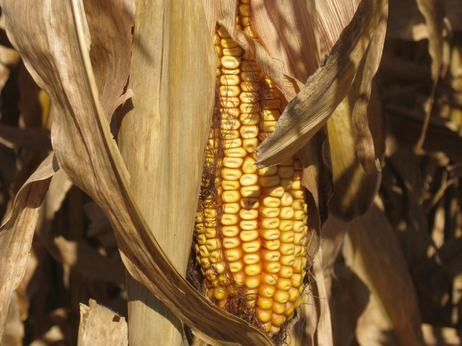For America's agricultural biotech companies, the corn rootworm is threatening to turn into their worst nightmare.
Last year, we reported that a major insect pest, the corn rootworm, had "found a chink in the armor" of genetically engineered crops. In several different places across the corn belt, the insects have developed resistance to an inserted gene that is supposed to kill them.
Now, in a letter to the U.S. Environmental Protection Agency released this week, 22 of the nation's top experts on corn pests lay out some of the implications of this discovery, and they are potentially profound.
In order to slow down or prevent the spread of resistance, the scientists are calling for big changes in the way that biotech companies, seed dealers and farmers fight this insect. The scientists urge the agency to act "with a sense of some urgency."
The rethinking that's laid out in this letter, in fact, goes beyond what the EPA is able to do under current law. For instance, the researchers want seed companies to stop routinely inserting anti-rootworm genes into their most productive hybrid seed lines. According to the letter, this practice means that farmers "often have few options" apart from rootworm-protected seeds — even in some areas where rootworms don't pose a serious problem.
When farmers plant hybrids that contain the same gene, year after year, it dramatically increases the chances that this gene quickly will become useless, because insects will become resistant to it.
The researchers are calling on farmers in some parts of the country to stop planting corn with anti-rootworm genes altogether, or to plant such corn only intermittently.
Patrick Porter, of Texas A&M University, who coordinated drafting of the letter, tells The Salt that some of these recommendations will be dismissed as "impractical" by many farmers and seed companies. But the group's credentials are impressive. It includes most of the non-corporate researchers who are currently trying to evaluate the extent and consequences of corn rootworm resistance.
If the recommendations in this letter were, in fact, put into practice, it would compel wrenching changes in the way that major seed companies like Monsanto and DuPont breed and market their corn seed.
Monsanto issued a statement responding to the scientists' letter, asserting that rootworms has caused excessive damage on just 0.2 percent of the acres where farmers planted Monsanto's rootworm-protected corn. This year, scientists from the companies and also universities plan to monitor fields for rootworm damage much more carefully than in the past.
So far, researchers have found insects that are resistant to just one of the three different anti-rootworm genes currently on the market. (For those of you who care about the details, it's called Cry3Bb1.) New corn hybrids now are on sale that combine two different anti-rootworm genes.
In theory, if the toxins produced by these genes kill rootworms in different ways, this "pyramid" of genes should dramatically reduce the chances of insects developing resistance. So the EPA is allowing corn growers to plant this new "SmartStax" type of corn on a larger area — up to 95 percent of a grower's corn acres.
Many scientists think this is a big mistake. They've collected data showing that the two genes, working together, are indeed more effective than any single gene — but the combination is not nearly as effective as people had hoped. In addition, "SmartStax" corn is being planted in areas where some insects may already be resistant to one of the genes, so it's not a true pyramid.
"It raises real questions about how stable this house of cards is," says Kenneth Ostlie, from the University of Minnesota.
The economic consequences of widespread corn rootworm resistance to genetically engineered crops could be enormous. Farmers who want to plant corn on their fields every year — and even farmers in some areas who rotate corn and soybeans — would be forced to rely on chemical insecticides. But Paul Mitchell, at the University of Wisconsin, says those insecticides don't work very well, and yields could suffer. Any significant dip in the corn harvest, Mitchell says, could produce "a huge spike" in the price of corn.
Some farmers could adopt other ways to control rootworm, rotating their fields into crops where corn rootworms cannot easily survive, such as wheat or alfalfa. But Porter says that's simply not an option for many farmers; they have to plant the most profitable crop — corn — in order to compete economically. "A lot of the time, farming is run by bankers now," he says.
Two experts who were not part of the group that sent the most recent letter, Fred Gould of North Carolina State University and Bruce Tabashnik, at the University of Arizona, have called on the EPA to require farmers to plant much larger "refuges" of corn that is not toxic to rootworms. They say it's the only reliable way to slow down insect resistance.
But Porter says that's not possible, at least this year. There's simply not enough conventional corn seed for such large refuges. He's wary of sudden regulatory shifts that could fundamentally disrupt production: "If we do the wrong thing, we could see corn at $15 per bushel." That's more than twice what corn costs today.

No comments:
Post a Comment